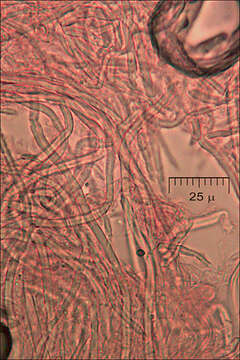Daedaleopsis-confragosa_hypha_5M

Kuvaus:
Daedaleopsis confragosa (Bolt.: Fr.) Schroet., syn.: Trametes rubescens (A.& S. ex Fr..) Fr.Blushing Bracket, Thin walled maze polypore, DE.: Rtende Bltterwirrling, Rtende Tramete Slo.: rdeea zvitocevka Dat.: Mar. 2. 2014Lat.: 46.36013 Long.: 13.70436Code: Bot_787/2014_DSC0179Habitat: mixed wood edge; Fagus sylvatica, Picea abies, Fraxinus ornus, Ostrya carpinifolia and Corylus avellana dominant; slightly inclined mountain slope; shallow, calcareous colluvial ground; relatively warm and dry place; partly protected by from direct rain by tree canopies; average precipitations ~ 3.000 mm/year, average temperature 7-9 deg C, elevation 570 m (1.870 feet), alpine phytogeographical region.Substratum: fallen off, dead, but still standing branch of Fraxinus ornus.Place: Lower Trenta valley, between villages Soa and Trenta, right bank of river Soa, next to the trail from Trenta 2 farm house to Trenta 2b cottage, East Julian Alps, Posoje, Slovenia EC.Comments: Daedaleopsis confragosa is a common fungus but a very plastic species with not yet settled taxonomy. Many mycologists split it into three species or subspecies Daedaleopsis confragosa, Daedaleopsis tricolor and rare Daedaleopsis septentrionalis. They don't differ microscopically. But, indeed one can find strikingly different specimens having from small, vividly and beautifully red pilei to dirt whitish and pale beige-brown examples with any possible kind of pore surface one can imagine, from purely lamellate or elongated pores, sometimes labyrinthine to purely poroid. Taking into account only macroscopic traits it is hard to believe for a laymen that all these forms are one and the same species. The find photographed is interesting because of its unusual round form. Daedaleopsis confragosa is usually broadly attached, bracket like form.Growing solitary; pileus diameter 4 - 4.5 cm and 1.5 cm thick; taste almost none, very mildly bitter; smell mild, mushroomy; characteristic reddish bruising of pore surface not seen, possibly because the pileus was already quite old; SP whitish, lightly beige, oac900.Spores smooth, cylindrical. Dimensions: 7.4 [8.3 ; 8.7] 9.6 x 1.6 [1.9 ; 2] 2.3 microns; Q = 3.8 [4.3 ; 4.5] 5; N = 44; C = 95%; Me = 8.5 x 2 microns; Qe = 4.4. Olympus CH20, NEA 100x/1.25, magnification 1.000 x, oil (spores); NEA 40x/0.65, magnification 400x (hypha) in water, in vivo. Contextual hypha without clamps, generative hypha with clamps not seen. AmScope MA500 digital camera.Herbarium: Mycotheca and lichen herbarium (LJU-Li) of Slovenian Forestry Institute, Vena pot 2, Ljubljana, Index Herbariorum LJFRef.:(1) L. Ryvarden, I. Melo, Poroid fungi of Europe, Synopsis Fungorum 31., Fungiflora (2014), p 164. (2) J. Breitenbach, F. Kraenzlin, Eds., Fungi of Switzerland, Vol.2., Verlag Mykologia (1986), p 304. (3) A. Bernicchia, Polyporaceaes l., Fungi Europaei, Vol. 10., Edizioni Candusso (2005), p 194. (4) G.J. Krieglsteiner (Hrsg.), Die Grosspilze Baden-Wrttembergs, Band 1., Ulmer (2000), p 508.(5) S. Buczacki, Collins Fungi Guide, Collins (2012), p 496. Nikon D700/Nikkor Micro 105mm/f2.8
Mukana seuraavilla sivuilla:
- Life
- Cellular
- Eukaryota (aitotumaiset)
- Opisthokonta
- Nucletmycea
- Fungi
- Dikarya
- Basidiomycota (Kantasienet)
- Agaricomycetes (Avokantaiset)
- Polyporales
- Polyporaceae (Käävät)
- Daedaleopsis (Särmäkäävät)
- Daedaleopsis confragosa (etelänsärmäkääpä)
Tämä kuva ei ole esillä missään kokoelmassa.
Lähdetiedot
- lisenssi
- cc-by-nc-sa
- tekijänoikeus
- Amadej Trnkoczy
- valokuvaaja
- Amadej Trnkoczy
- alkuperäinen
- alkuperäinen mediatiedosto
- käy lähteessä
- kumppanisivusto
- Flickr Group
- ID


